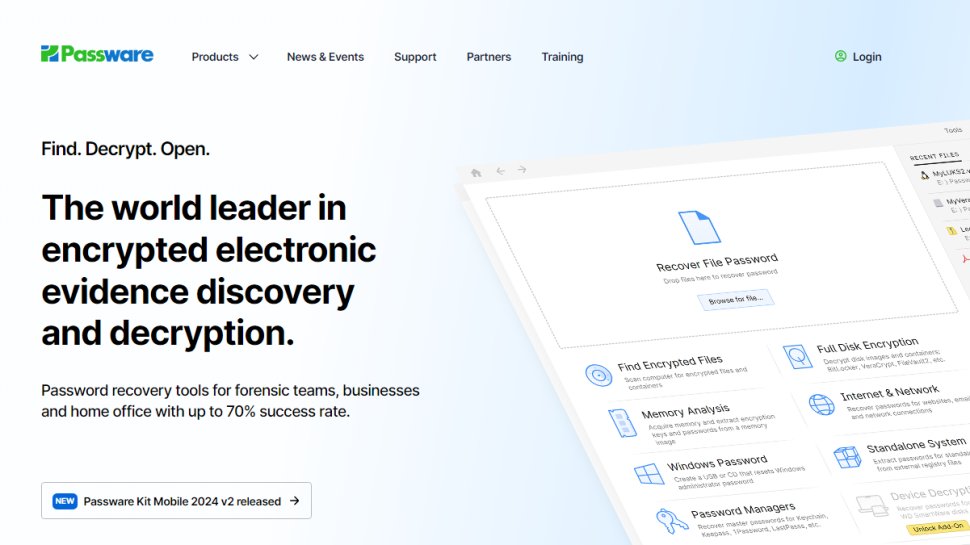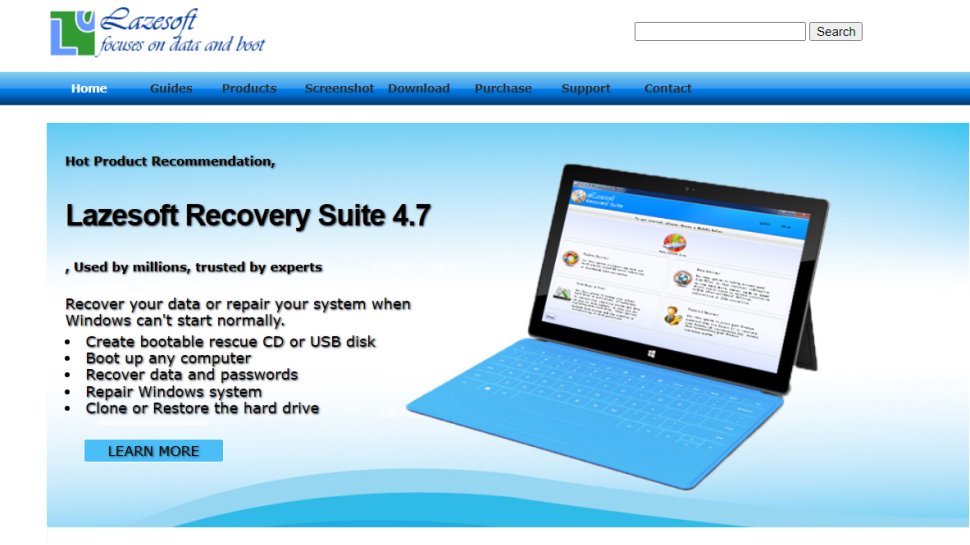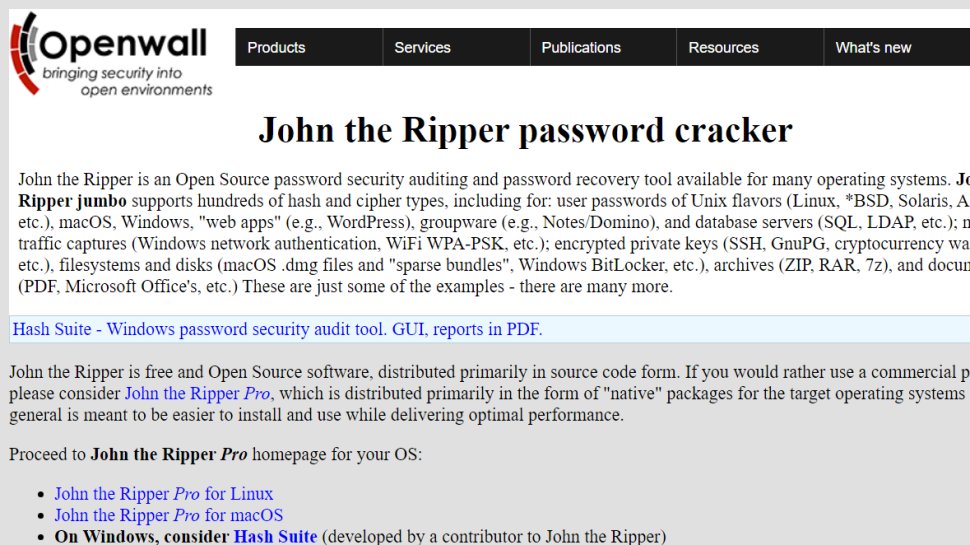Best Password Recovery Software of 2025: Our Expert Picks to Unlock Your Accounts
I've ranked the best password recovery for software and hardware

The best password recovery software is purpose built to help you regain access to accounts and hardware for which you have forgotten or lost the password.
These tools use the methods of the bad guys for good, taking advantage of brute force techniques and combinations of familiar passwords to come up with the most likely credentials for your account. Once you've recovered a password, or to stop you losing it in the first place, take a look at the best password managers.
TechRadar Pro's team of security experts have been reviewing password recovery tools since the naughties and beyond, testing some of the best known services such as Passware, Lazesoft, and Ophcrack, looking at essential features such as device and hardware compatability, ease of use, value for money, and additional features.
So, here are my top picks for the best password recovery software, including some helpful FAQs on picking a recovery solution for you, and some help with remembering and storing your password.
We've also highlighted the best free password manager.
The Best Password Recovery Software of 2025 in full:
Why you can trust TechRadar
Best password recovery software overall
1. Passware Kit
Our expert review:
Reasons to buy
Reasons to avoid
Passware is a leading password recovery software developer that has a success rate of about 70%, which is quite good, considering the task at hand. The Basic, Standard, and Standard Plus kits are all intended for home use, although there are Business and even Forensics solutions available, depending on how difficult the job is.
The Basic kit, which costs $49, can recover passwords for 80+ file types, including Microsoft Word, Excel, and popular web browsers. You can use it to reset local Windows accounts, including the admin account, as well as Microsoft Live accounts.
To unlock more file types like PDFs, and compressed archives you can use the $79 Standard kit. The top-tier $195 Standard Plus variant can reset Windows Server accounts, and can also unlock some of the best password managers like LastPass, 1Password, and Dashlane.
Passware Kit Business is also available for organizations, offering business-specialized password recovery software for a single payment of $945. Additionally, there are Forensic and Ultimate kits for $1,195 and $3,995 respectively with an additional range of features and file types.
While somewhat costly and like all solutions, not guaranteed to work in every case, the three Passware kits are a good place to start.
Best free password recovery software
2. Recover My Password Home Edition
Our expert review:
Reasons to buy
Reasons to avoid
Recover My Password by Lazesoft is a freeware option for recovering a Windows admin password. You can remove the Windows password entirely, reset it to blank, and unlock, enable, or disable user accounts.
The Home edition has a graphical user interface, making it simple to use. Just follow the step-by-step instructions to create a bootable media, which could be a CD or a USB drive, that you’ll use to recover your passwords. The business version builds on the free home edition and is priced $17.95.
There is also a Server edition for $79.49, and and Unlimited license for $159.69 which may be more suitable for business users.
Lazesoft claims a 100% recovery rate but doesn't provide any sources or data into this claim. Besides resetting passwords, it can also repair non-bootable Windows installations, recover data from a crashed hard disk, clone and backup partitions or entire disks, and more.
Finally, Lazesoft has free technical support available, so if you get stuck, you can check out its comprehensive FAQ and knowledge base, and then if necessary, contact by email.
The only downside is that you’ll need a separate boot media for each edition of Windows. For instance, if you need to reset passwords on both a Windows 10 and a Windows 11 machine, you’ll need to create two different recovery media.
Best multi-platform password recovery software
3. John the Ripper
Our expert review:
Reasons to buy
Reasons to avoid
Don’t let the name scare you: John the Ripper is a reputable password recovery tool available for Unix, macOS, Windows, and others. The free version is only available in source code, which isn’t well suited to novice users. However, a Pro version is available for Linux and macOS, with a seven-day money-back guarantee.
In both cases, there’s no graphical user interface, so if you’re not familiar with command-line, this tool is probably not for you. You’ll also have to manually extract the password hashes from the Windows SAM and System files, which just adds to the complexity of using the app.
Then there’s the fact that even if you take the free version, the wordlists required to crack the passwords are paid. You can try cracking the passwords without the wordlists, in which case the app will try and brute-force the password, which could take several hours or even days depending on the complexity of the password. There’s also a mailing list where you can ask questions if you run into any trouble, although responses may vary in promptness and usefulness.
Trinity Rescue Kit used to be featured on this list, but since it has not seen a stable release update since 2016 it was removed. The software is technically obsolete and may not be compatible with with Windows 10 or Windows 11, and may experience issues with other hardware and operating systems.
We've listed the best password generators.
October 2025 Update: In this update I have removed outdated software, updated the specifications and features of each product, and enhanced the guide with a new introduction and updated FAQ. I have also outlined that while Trinity Rescue Kit has not had a stable release since 2016, it is still capable of resetting user and administrator passwords on Windows. I have also removed Ophcrack and Trinity Rescue Kit from this list as it both are no longer capable of password recovery on Windows 10 or Windows 11.
Password recovery FAQs
How to choose the best password recovery software
When deciding which password recovery software to use, first consider what your actual needs are, as budget software may only provide basic options, so if you need to use advanced tools you may find a more expensive platform is much more worthwhile. Additionally, higher-end software can usually cater for every need, so do ensure you have a good idea of which features you think you may require from your password recovery software.
What are the most common and effective ways to recover a password?
We probed Denis Gladysh, co-owner and head of Passcovery, a supplier of high-speed GPU-accelerated software solutions for recovering passwords of popular file format, to find out what the most popular ways to recover lost passwords are.
By skillfully customizing the range you may staggeringly reduce the number of trial passwords. This will still be a brute force attack, only with a limited range of combinations:
Mask is a part of the password that you know some specific details about. It remains unchanged throughout the entire attack, while only the unknown part is being changed. Not the most common case, of course. For example, if you know that the password begins with the name Jack, ends with the year of his birth - 56, and there are some characters in the middle, then by using the mask - Jack?????56 - you could check all 11-character passwords beginning with Jack and ending with 56.
When you do not know the exact characters of the password, but you do know its structure, then using the extended mask attack you can define an individual charset for each position in the password. Trial passwords will only consist of the characters from the defined charsets. Only a few password crackers offer this feature. Passcovery (review/website) is one of them. For example, you know that the password begins with a capital letter, ends with numbers, and there are only lowercase letters in the middle. So it only makes sense to try passwords that meet these specific criteria. The extended mask option allows to check such passwords.
Oftentimes a password is not a set of random characters, but a meaningful word: a name, date, nickname, favorite movie/cartoon/book character, dish, country name, etc. Such topical lists of words and their combinations are called dictionaries. And a password attack based on such wordlists is referred to as a dictionary attack. By running a dictionary attack you can quickly check all popular passwords. For example, over the last few years the password 1234567890 has been top-rated as the most popular one. OMG! 10 characters! Gotta be strong enough, you think? Yeah, right :)
What if we combine several words into a single password and alter characters in it? We'll get a password that is too long for a regular brute-force attack and that can never be found in any dictionary. And yet it is possible to recover it by combining multiple dictionaries and setting character mutation/substitution rules. Passcovery programs can handle such tasks. See for example the case of Apple iOS 13.x backup file. Then we compiled a list of likely words that could possibly make up the password, added mutations rules, ran the attack and successful ly recovered the lost password.
Which attack to choose from the four listed and its efficiency depends on each specific case. Say, you know the words that make up the password, then dictionary attack with rules is what you need. If you know the structure or a part of the password, then you'd better go for extended or regular mask attack. When you don't know any details about the password, it is recommended to run a dictionary attack using wordlists of popular passwords. And still, there is no guaranteed way to recover, let alone crack a properly made and secure password (and that is great, isn't it! otherwise what's the point in protection, if anyone who has a computer could crack it?). There is no 100% guarantee, but success is still possible.
With an effective software tool, high-performance hardware, and a little information about the password, you get pretty high chances to successfully recover your lost password.
NB: All of the above refers to the latest types of secure password protection with encryption and does not apply to protection against accidental editing. The latter can always be removed instantly (as, for example, in Microsoft Office 2-2019)
What are the risks of using password recovery software?
First and foremost, password recovery software should only ever be used responsibly and ethically. It shouldn't be used to crack passwords on account belonging to anyone but yourself unless you receive express permission from the account holder.
Secondly, only use password recovery software from trusted sources. Third-party software can often be hijacked or imitated to install malware or steal the very passwords you are trying to recover.
Thirdly, consider using the password recovery tools provided by the software or hardware you are trying to regain access to. For example, if you have forgotten the password to an online account many websites will provide a 'Forgotten your password?' link that leads to a trustworthy password recovery service.
Finally, if you do choose to use password recovery software on your device, considering using the best backup software to make a full cloud backup of your device in case anything goes wrong.
What is the difference between free and paid password recovery software?
There are several key differences between free and paid password recovery software.
Free software may only allow you a certain number of attempts or uses before forcing you to upgrade to the paid version. Sometimes free versions won't offer the full suite of password recovery tools making it harder for you to successfully recover a password.
Paid versions on the other hand will often provide a more comprehensive suite of tools for recovery passwords from a wide range of mediums. They will also often include priority customer support options such as email ticketing or live chat services.
What are the best ways to store my password securely to prevent future loss?
The best way to store passwords securely is by using one of the best password managers. The entire point of these tools is to generate, store, and autofill your credentials securely. Passwords are stored in an encrypted vault that will often require some form of authentication to access such as a biometric facial or fingerprint scan, or a passkey.
Speaking of passkeys, they are significantly more secure that passwords and are highly phishing resistant meaning that if a crook does get their hands on your full username and password, they will be unable to access the account without passkeys.
Many online services and apps offer passkey support, with numerous companies heading towards an entirely passwordless login process using passkeys.
How we test the best password recovery software
To test for the best password recovery software we first set up an account with the relevant software platform, then we tested the service to see how the software performed when accessed by different devices, as well as testing any additional tools that were provided. The aim was to push each password recovery software platform to see how useful its basic tools were and also how easy it was to get to grips with any more advanced tools.
Read more on how we test, rate, and review products on TechRadar.
Get in touch
- Want to find out about commercial or marketing opportunities? Click here
- Out of date info, errors, complaints or broken links? Give us a nudge
- Got a suggestion for a product or service provider? Message us directly
- You've reached the end of the page. Jump back up to the top ^
Sign up to the TechRadar Pro newsletter to get all the top news, opinion, features and guidance your business needs to succeed!

Benedict has been with TechRadar Pro for over two years, and has specialized in writing about cybersecurity, threat intelligence, and B2B security solutions. His coverage explores the critical areas of national security, including state-sponsored threat actors, APT groups, critical infrastructure, and social engineering.
Benedict holds an MA (Distinction) in Security, Intelligence, and Diplomacy from the Centre for Security and Intelligence Studies at the University of Buckingham, providing him with a strong academic foundation for his reporting on geopolitics, threat intelligence, and cyber-warfare.
Prior to his postgraduate studies, Benedict earned a BA in Politics with Journalism, providing him with the skills to translate complex political and security issues into comprehensible copy.


